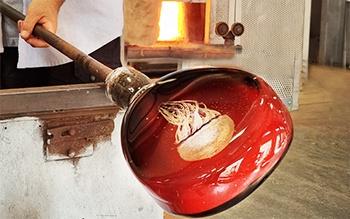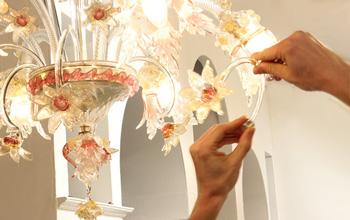Aesthetic and functionality mould themselves in one product, rigorously hand-made by the Murano masters, as well as creativity and expertise mould themselves times to times in the prestigious island’s furnaces. In the meantime, the vitreous matter is slowly transformed in one of the most renowned artwork of the lagoon tradition.
The venetian tipetto is, actually, something more than a simple chalice. With good fortune throughout the centuries, its productive process has kept its phases unchanged, despite the improvement given by the modern technologies. It is a fragment of history that can confer to a laid table such added value that only art is able to enhance.

A royal elegance
Marvellous goblets with proud stem which appear with timeless charming style, often recalling to flora & fauna, from the most traditional with a jumping dolphin or crossing leaves, to the ones more essential, with an elegant sphere rounded by a light garland; or to the most complex and glitzy, with volutes and small arches, rampant winged animals almost referring to heraldry or rather with vitreous inserts capable to remind tiaras and crowns.
Precious notes that throughout the long history effectively have attended also during the reach meals in the most important European courts and even the more remote ones. As precisely demonstrated by the sixteenth-century luck of the tipetto, mostly given by Caterina De Medici, wife of the France king Henry II of Valois from 1547 to 1559 and reigning herself from 1560 to 1563, called Queen Mother due to having given birth to three subsequent transalpine sovereigns: Francis II, Charles IX and Henry III. Cultured and polished woman, she has care of introducing in the adopting land meals and wines from the already sophisticated Italian cuisine, together with the refined Murano’s wine glasses for the libations: from that times onwards, they became essential elements in the most important lunches and dinners of the courts on an international scale.
But how is the Murano’s tipetto realised?
- 1) Generally, all begins with a sketch, fascinating projection of the Master’s inspiration which from the creative tops of his head flows in drawing shape on a paper through a pencil, or rather more suggestively through chalk on a stool or a metal table.
- 2) The Master put the proper quantity of melted glass, gathering it around the extremity of a hollow metal rod (process similar to the one of stick and cotton candy) and blowing into the opposite extremity in order to obtain a little malleable sphere.
- 3) With quick touches of a nipper the Master shapes expertly this first vitreous agglomerate and through the help of a colleague – in dialect called servente or serventin – who get to the master little quantities of melted glass with another rod, he creates some decoration in elevation around the incandescent sphere.
- 4) The servente gets closed to the Master keeping in front of himself his metal rod with melted glass in the extremity and the Master – using a nipper for looking better after the assistant – links the matter offered by the sphere, properly heated for being accommodating. Here it is, for a few moments the processing sphere is linked to two metal rods at the same moment.
- 5) Then, the Master separates his rod from the vitreous matter, pick the one of the assistance and by using a bit metal nipper, he literally opens the sphere broadening the hole leaving by the rod. Thus, thanks to the expertise touch of the hand the tipetto’s cup.
- 6) Master and assistant, in careful synergy, work for shaping the stem. Working with nipper and big scissor, they prepare the ornaments which will be integrated into the stem (for example curved leaves and flowers) and, once the thin supporting structure is ready, they connect the priors to the latter.
- 7) The only part missing is the base of the tipetto, the support of the chalice. The third and last component is obtained putting the proper quantity of vitreous matter on the free extremity of the stem while on the other is still secured to the metal rod. After having moulded the added glassy part making it a spherical form through the rounding movement of the rod the nipper is used again similarly to the process of the cup: the sphere is rapidly broadened in order to obtain a shape close to a trunk of a dug cone.
- 8) To the stem-base block as such is linked the cup already realised and thus, through the magical dance of the mind, eye and hand, the Master extracts from the shapeless matter a Murano’s tipetto perfectly made. The tipetto is a model of the glass art into which each element created is able to reinvent – in an absolute unique manner – a charm that persists immutable throughout the centuries.











